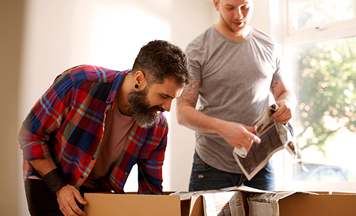From the time you sign the contract of sale for your new home, it can be a period of weeks or even months before your settlement date (the day the property officially becomes yours).
During the settlement period, there could be new damage or deterioration to the condition of the property, or there could have been things removed that were part of the sale contract. The final house inspection – also called a pre-settlement inspection – allows you to identify anything that needs to be sorted out before settlement.
Let’s take a look at the final inspection checklist, so you know what to look for during the final inspection.
Pre-settlement inspection checklist
On the final inspection day, do a walk-through of the property looking for damage that may have occurred since your sale was finalised. You’re also checking that everything is clean and in the same working order that it was when you exchanged contracts. You want to ensure everything included in the contract of sale is still in place and that rubbish is removed.
Here are some things to check during a final inspection:
Electrics
Check everything electric is in working order
- Electrical switchboard
- Telephone line
- Light switches
- Power points
- Exhaust fans
- Ceiling fans
- Dimmers on lights
- Automatic blinds
Plumbing
Check that everything is in working order with no leaks
- Water taps, mixers, shower roses and hand showers
- Water filtration system
- Water tanks
- Bore pump
- Sinks, baths and showers – run the water to ensure it drains properly and check hot and cold water are working
- Check plugs are present and they fit
- Toilets – check they flush
Fixtures
- Door handles and locks
- Window locks and stays
- Windows and windowpanes
- Stove, cooktop and oven
- Built-in microwaves, refrigerators, or other appliances
- Dishwasher
- Air conditioner
- Evaporative cooler
- Heat pump or other heating units
- Water heater
- Flooring – carpets, tiles, linoleum, etc
- Attic stairs
- Fireplace
- Lighting fixtures
Fittings
- Blinds and curtains
- Smoke alarms
Outdoors
- Gas meter
- Letterbox
- Doorbell
- Outdoor taps
- Pool pump
- Spa
- Garage door and remotes
- Rubbish bins
Special conditions
- Inclusions as part of the contract of sale – anything extra that was designated as part of the property purchase
- Exclusions as part of the contract of sale – anything that should not be there
General damage
- Check for general damage such as leaks, and insect or pest infestations
- All rubbish is removed
Why is the final inspection important?
As the buyer, you’re allowed to inspect your new property before settlement to make sure everything is in the same condition as when you purchased it. The final inspection allows you to identify anything that isn’t in the same working order or anything that has been damaged in the time since you went unconditional. You can then request the vendor to rectify it prior to settlement.
A final inspection also allows you to check if any special inclusions or exclusions to the sale contract have been fulfilled. For example, anything that was identified as needing attention in the pre-purchase checks, such as a repair or an item needing removal.
When should the final inspection happen?
Try to arrange your pre-settlement inspection around five working days before settlement. This allows enough time for the vendor to fix any issues that arise from the inspection prior to settlement. You can leave the final inspection up to several hours before settlement. However, if you do find a problem, a few hours doesn't leave you much time to negotiate or to have issues fixed.
Ideally, you would undertake the final inspection once the owners or tenants have moved out, but this is not always possible. If there are still belongings at the house, you can ask your solicitor to request an assurance from the vendor that all items will be removed prior to settlement. It is best practice to highlight any issues before settlement because once you’ve completed the sale it can be harder to get the vendors to fulfil their obligations. If there’s still a big pile of rubbish in the garden, for instance, you might have to pay to have it removed yourself.
You need to give the vendor a reasonable amount of notice to ensure they are ready for the final inspection. You can ask the real estate agent to arrange a time that suits both parties. If it is a private sale, you could arrange this directly with the vendor.
Who should do the inspection?
Normally the purchaser would do the inspection. It's common to bring the real estate agent as well. Sometimes the purchaser can also hire a pre-settlement inspector.
If you can’t attend a final inspection, you could ask the real estate agent or an independent inspector to undertake a property inspection on your behalf.
What should you check during the inspection?
It's a good idea to bring your contract of sale with you to the inspection. Listed under the special conditions, you will need to check any inclusions and exclusions to the standard contract.
These may be additional fixtures or fittings that you requested the vendor to leave. For example, you might have agreed with the vendors that the washing machine and dryer would stay in the house, so you need to check they’re still there and working.
There might be items that need repairing or replacing, like a window latch that was broken or lightbulbs that needed replacing. And there are sometimes specified items that need to be removed, like a falling-down garden shed or a broken oven.
You can also bring:
- A camera or smartphone to take photos of anything that needs attention.
- A small appliance like a phone charger to check power points are working.
- A step ladder to check anything that is too high to reach.
- A notepad and pen to note down any questions, concerns or problems that need addressing so that you can share them with your solicitor.
How to fix an issue identified in your inspection
If you identify something that isn’t as it should be during your house inspection, let your solicitor or conveyancer know. It is the previous owner’s responsibility to remedy any problems before settlement.
Your solicitor may communicate the issue to the vendor’s solicitor and come up with a solution that both parties are happy with. If you’re not happy with the suggested solution, let your solicitor know so you can reach a solution that suits both you and the vendor.
Solutions may include rectifying issues before settlement – fixing a leaky tap or removing rubbish, for instance. Alternatively, the vendor might agree to compensate you for the cost of having an issue remedied once you move in. For example, if you agree that it will cost roughly $200 to have the leaky tap repaired, the vendor may be happy to pay you that $200 rather than trying to organise a plumber before settlement.
If the previous owner does arrange repairs to the property, your solicitor may request that a second pre-settlement inspection takes place to make sure you’re satisfied with the repairs, especially if this was to repair significant damage. This means if they tell you they had a plumber round to repair that leaky tap, you might like to go back and make sure you’re happy with the job that’s been done.
There are lots of ways to rectify issues that arise from final house inspections, so don't worry if you need to address a problem. It can be difficult to request vendors fix problems after settlement when they no longer own the property and they have the proceeds of the sale in hand.
Having a building inspection completed by a qualified professional can also be a good idea. The building inspection should be done before you purchase.




